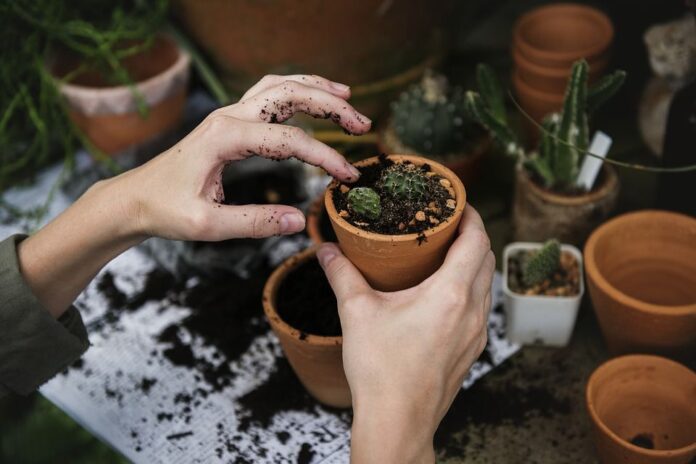BY Lori Murray, , Texas Superstar Specialist
Planting your container is simple, but if you don’t have a potting bench or good location for potting, it can make a mess. To avoid this, use a tarp on the ground where you plan to work. When you have finished, you can carry the tarp off and empty it in a safe place. You might also want to have a cart or box to raise the new container to a comfortable working level (and save your back).
It’s important that the level of soil on the plants remains the same in the new pot as it was in the original pot. To begin, fill the clean container about halfway full. Ultimately you will want the soil to be within an inch or so of the rim, but first you need to determine what that midway level should be for the plants you are going to use.
One video made a great suggestion for planting the thriller and the filler plants in a big container: Immerse each pot that you will be adding to the planter in water for a couple minutes to get it thoroughly watered. Then remove all the plants from their original pots and place the empty pots in the new container.
This way you will know if you have the correct depth of potting soil or if you need to add or remove soil. Then fill in around the empty pots with soil until the top of each pot is an inch beneath the top of the big container. You can really pack the soil in between pots without fear of damage that you might do to a plant. Then loosen the roots of each plant and spread them so that they will grow out into the container.
If the roots were wound around the inside of the original pot, you can either trim them with shears or pull them gently apart from the root ball to encourage growth out away from the original form. Then remove the pots one at a time and replace each one with the watered plants themselves, adding a bit more soil if necessary. Finally, work the spiller plants into the filler plants, positioning any trailing sections to the outside and water the entire container thoroughly.
Another video suggestion was to toss a generous handful of seeds for a climber that would look good next season into the pot. This could give your container new life and a new look a month or two down the line.
SOME THINGS TO REMEMBER:
If you are using very large pots, consider a layer of pea gravel and a coffee filter in the bottom to aid drainage. Also, you can keep very large pots from getting too heavy by using a layer of Styrofoam pieces or peanuts in the bottom of the pot. Mix moisture-retaining materials into the soil if it does not already contain them. Keep the soil level on the plant’s stem the same as it was in the original container. Press the soil firmly and securely around the root ball.
Planting closer together than the recommended spacing will usually create faster, fuller growth and the plants will mature and bloom sooner. Of course, they might also need to be moved to a larger container sooner, so calculate what you wish to achieve and when! If you are using a variety of plants in the same container, be sure not to plant low growing plants in the center where they will be covered and overpowered by larger growing plants on the perimeter.
Balance is important. Consider starting combination plantings with only two or three varieties until you have some experience with such options. Water the container immediately after planting. If the soil settles and exposes the roots, add a little more soil.
WATERING
Each container of plants may have different watering needs during different seasons. Check the soil 3 to 4 inches deep before flooding the container. You can either check the soil with your finger, or you can invest in a moisture meter (purchased at a garden center or at Tractor Supply). Check containers daily until you get an idea of which container needs what and when.
When you water, water thoroughly. Skimpy watering will cause your plants to have shallow roots, and the plants will develop poorly. Container drip irrigation kits abound and are wonderful for efficient, easy watering of very large containers such as raised beds. They’re especially nice when you leave on a vacation or trip. These are available at some garden centers or online at numerous places.
FEEDING
Select fertilizers to suit the needs of your particular plants. Flowering plants will need a high phosphorus fertilizer such as a Super Bloom. Foliage plants will need a more balanced fertilizer or one with higher nitrogen. Water soluble fertilizers help you avoid the possibility of burning that granular fertilizers tend to produce when used in containers, but granular fertilizers can work equally well if you keep in mind the importance of watering thoroughly. Fertilize vegetables with a good garden fertilizer formulated for vegetables and tomatoes. Then sit back and watch the fruits of your labor materialize.
Sources:
Author’s Personal Experience
Country Gardens Container Gardening Special Interest Publications, Meredith National Media Group, Des Moines, Iowa.
www.fine Gardening.com
aggiehorticulture.com
Pinterest – container gardens





